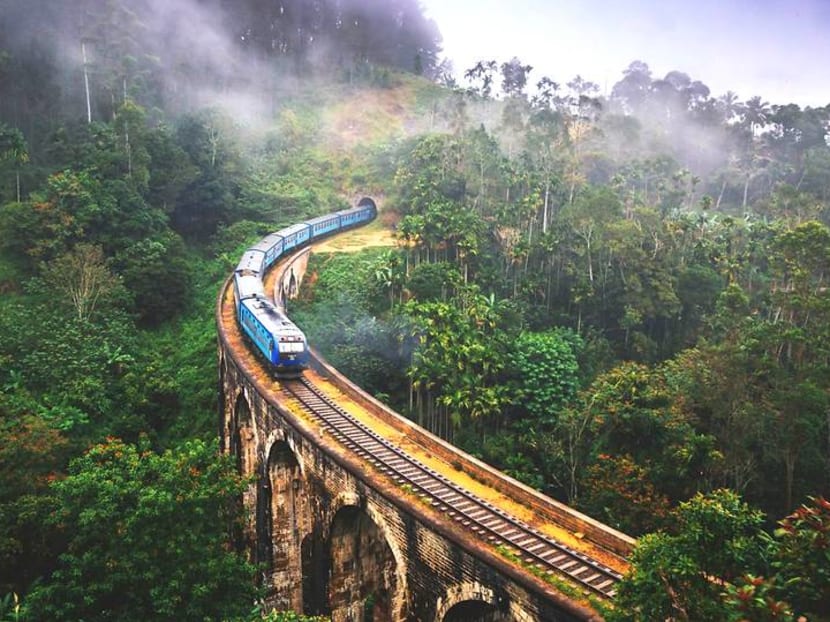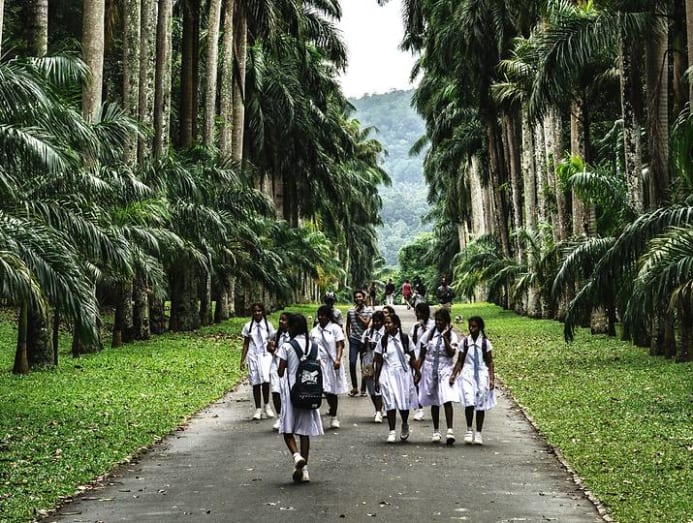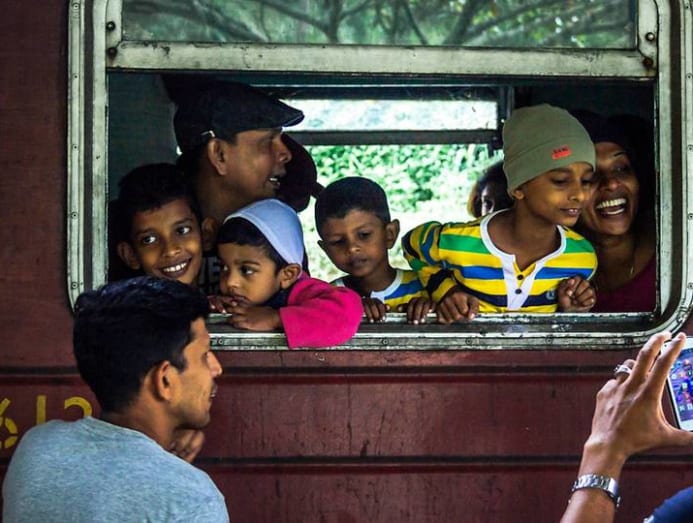Sri Lanka, an island nation that is best savoured slowly
Advert
CNA Lifestyle
Sri Lanka, an island nation that is best savoured slowly
The small isle nation off the southern tip of India is full of fantastic food, kind people and natural wonder – and is best seen slowly.

The fortunate visitor arrives at the colonial-era Ix Arch Bridge just as a railroad train comes around the curve. (Photo: David Blacker © The New York Times)
It's common while travelling to exist approached by locals trying to brand a few a bucks past offer to show you lot around. I typically respond with a polite "no", simply on this particular morn in Kandy, a small-scale city in the centre of Sri Lanka, I was looking for someone to accept me on a tour of the sights.
Santha, a small, center-aged man with a big smile, must have sensed it, because he made a beeline for me as I approached the small park near the Kandy Municipal Market on Sri Wickrama Rajasinghe Mawatha Street in the centre of town.
After a quick negotiation nosotros were off, crammed into the back of a bluish tuk-tuk, zooming downwards streets slick from the forenoon's rain and smelling of wet leaves. Santha yelled to me over the loud buzz of the machine rickshaw's engine: "I was born in Kandy, raised in Kandy and married in Kandy." He added, "And I will die in Kandy!"

I could easily have spent months in Sri Lanka, the small island nation off the southern tip of India. Full of fantastic food, kind people and astonishing natural wonder, Sri Lanka is a place best seen slowly, even if you but have iv days on the ground like I did.
The train was my preferred means of transport (when I wasn't in a tuk-tuk), winding from Colombo to Kandy, in the middle of the land, before taking another train down to Ella, on what was one of the most beautiful and scenic train rides I've always experienced. And as far as cost goes, I was able to keep my expenses comfortably nether control.
First, some logistics: A railroad train trip in Sri Lanka requires planning. Many popular routes, including the one from Kandy to Ella, can sell out reserved seats weeks in accelerate. The Sri Lanka Railways website isn't going to be much help here: You lot can only reserve tickets in person or through your local mobile telephone. I consulted the website The Man In Seat 61 and eventually decided to identify my trust in Visit Sri Lanka Tours to make my bookings.
My ticket in the ascertainment car from Colombo to Kandy, with comfortable seats and a big picture window at the front of the compartment, cost 11 pounds (S$19) for the two-and-a-half hr ride. (The bureau is UK based and charges in pounds, payable through PayPal.) I snagged the last reserved 2nd-grade seat on the Kandy to Ella road – this is with booking xx days in advance – and paid thirteen pounds for the more ponderous, nearly seven-60 minutes jaunt through the green hills and tea plantations of cardinal Sri Lanka.

I picked up my ticket at Colombo's Fort Railway Station and had simply enough time to stop at the nearby Highland Milk Bar for a quick snack: A flossy chocolate milk from a drinking glass canteen, and a handbag of chips toll me 120 Sri Lankan rupees (S$0.xc). The beginning part of the ride heading east was unexceptional, but things changed around Rambukkana. All of a sudden the air seemed heavier, and the vegetation became thicker and denser as we passed each successive train station, painted in muted pastels.
Pelting rain greeted us as we entered Kandy, once its own contained kingdom on the island until it roughshod victim to British colonial ability in the early on 19th century. I put on a poncho I'd brought for the occasion and walked down William Gopallawa Mawatha Street in search of my lodgings.
"Gamage?" I asked passers-past, unsure how to pronounce the proper noun of the family who was hosting me. Eventually, someone pointed me toward a fluorescent light inside a small grocery, and I sloshed toward it. A woman peered out the door and waved. "Peterson?" she yelled from across the street.

The lovely Gamage family (pronounced GAH-mah-gay), consisting of parents, children and extended family all under one roof, put me up for two nights in their dwelling for most US$ten per dark, booked through the site Hotels.com. My room was basic merely comfortable, and came with an outstanding breakfast spread every morn: Curried mango, daal, beans, beets, rice, eggs and tea. Mrs Gamage told me I could hands find someone in a tuk-tuk to show me around boondocks.
When I constitute Santha the next twenty-four hour period near the park (or rather, he found me), nosotros quickly agreed on a price for a tour of the metropolis: 2,000 rupees. "Nosotros have very expert history here," he said to me as the tuk-tuk laboured uphill toward Sri Mahabodhi Maha Viharaya Buddhist temple, a petty over a mile from the town center. Sri Lanka is a majority Buddhist nation, and many of the culturally and historically significant places of worship are Buddhist.
Afterward spending some time admiring the giant statue of Buddha that the temple is famous for (and paying the 250-rupee entrance fee), Santha, our driver and I made a few more stops in the expanse. Some were clearly an attempt to get me to purchase something, only I didn't heed: At the Pilimathalawa Tea Manufacturing plant, for instance, a quick and interesting tour of the grounds was followed by an elaborate tasting and sales pitch to try to get me to buy tea.

When I bought a package of broken orange pekoe tea for one,200 rupees – which I was going to buy anyway – the salesman immediately said that if I bought a second ane, I'd get the third for free. He balked when I suggested he give me one package for 800 rupees, however, and I walked out with my single package of tasty, locally grown tea.
After a visit to a government-run medicinal garden and a stop for a quick beer (100 rupees buy you a local Anchor beer from the supermarket), we zoomed back toward boondocks, Santha narrating as we went along. "Very dingy right now," he said as nosotros crossed a muddied-looking Mahaweli River. Why would I choose to visit Sri Lanka now, during rainy season? he asked me. I didn't have a good reply.
The Royal Botanic Gardens was the terminal stop on our tour. Despite the relatively hefty entrance fee (one,500 rupees for foreigners, 60 for locals), I found the gardens a lovely respite from the traffic and hubbub of the expanse. They seem more like an arboretum than annihilation else, and I admired maze-like java fig trees, a towering polish-barked kauri and a fascinating cannonball tree, which holds dozens of big, spherical fruits.

The nutrient is wonderful in Sri Lanka; bright flavours, sharp spices and complex curries usually eaten with rice as the centrepiece. I thoroughly enjoyed the Flavors of Sri Lanka cooking class I booked as an Airbnb feel (U.s.a.$22), with the friendly Chitra taking the lead and her daughter Hasara assisting. Learning nigh the dissimilar spices and produce was a delicious and elucidating didactics, similar gotu kola, an herb, and goraka, a pocket-size, sharply acidic fruit that's unremarkably dried and used to flavor meat and fish.
A 400-rupee tuk-tuk ride from Chitra's house on the western side of town took me to Sri Dalada Maligawa, or Temple Of The Sacred Tooth Relic (1,500 rupees admission) only in time for the vi.30pm puja or worship ceremony. Hundreds of people packed into the temple, fragrant with flowers and ringing with the rhythm of drums beaten by men in traditional dress.
After the puja, I wandered due north along a narrow moat until I came to a homo standing in front of an old, regal-looking building. He introduced himself as Vipula, and we chatted virtually the edifice, which was the residence of Kandy's rex until the British seized the kingdom in 1815. The king, Vipula said sadly, was betrayed by his own people.
After an early breakfast the side by side forenoon, I boarded a bright blueish train to Ella, a modest town southeast of Kandy. Travelling by train is one of my favorite ways to get to know a identify: While assuasive one to truly have a sense of moving from ane identify to another, it also creates a sense of community and shared feel with others aboard. From my second-class seat (about US$16.50, again booked through Visit Sri Lanka Tours), I could savor the percussive clacking of the train as it wound through the intensely lush, hilly terrain, with row later row of perfectly manicured tea plants dotting every gradient.

With tourists and locals hanging out of the doors and windows – some to become a proficient selfie, others to get some air – we pulled into Ella station. I made the brusque walk to the Sunnyside Holiday Bungalow, where I had booked a room for simply under Usa$30 per night. The owners are kind and the holding, with gardens and a large shaded porch, is beautiful. The one downside is that at that place seems to exist a trash-processing facility across the route, which tin be slightly dull when the wind blows the wrong way.
Ella's downtown is geared to tourists and backpackers – think Western-style coffee shops, bars and souvenir stores – so I didn't spend much time there. My get-go forenoon in Ella, I set up out to discover the Nine Arch Bridge, a gorgeous, old colonial-era railway bridge that has, as y'all might expect, nine big arches. I was fortunate to get in merely equally a big ruby-and-light-green engine with a few cars behind it came barrelling around the bend.

After a morning of walking effectually, it started to cascade. I ducked into the restaurant at the 98 Acres Resort & Spa, which sits atop a hill and provides an awesome view of the surrounding countryside, even in the rain. I sipped a cappuccino (400 rupees) and lamented the weather.
Just an hour or so afterwards, I had my chance. The downpour had eased to a lite smattering, and I set out to hike Little Adam's Peak, a slightly rigorous but very achievable trek to the south. It was a bit more difficult after the rain, but the trade-off is that I had information technology all to myself; I didn't see a soul on the way upward.
Nor was there anyone at the elevation. I approached a small shrine that had a covered aureate Buddha statue and multi-coloured prayer flags fluttering lightly, and admired the vista of depression-lying clouds resting gently on what seemed like an endless series of rolling, green hills. Even through the pelting, information technology was a spectacular sight.
Past Lucas Peterson © The New York Times
Recent Searches
Trending Topics
Source: https://cnalifestyle.channelnewsasia.com/cna-lifestyle/sri-lanka-island-nation-best-savoured-slowly-235026

0 Response to "Sri Lanka, an island nation that is best savoured slowly"
Post a Comment